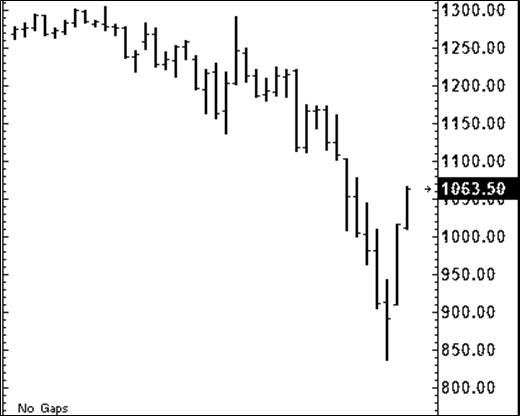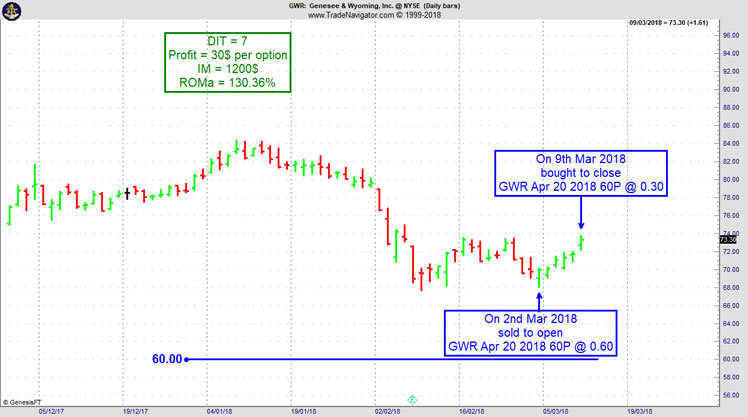Edition 721 - April 6, 2018

We are sorry for any inconveniences. Our website is under temporary construction to fix missing graphics and shopping cart errors.
Please email us at This email address is being protected from spambots. You need JavaScript enabled to view it. if you have questions or experiencing errors while placing an order. Thank you in advance for your patience.

by Master Trader Joe Ross
Author, Trader, Trading Mentor, and Founder of Trading Educators, Inc.
Developer of Instant Income Guaranteed
Chart Scan with Commentary - Volatility
You may laugh at what I'm going to say and show you next, but all I can say is that there was no need to suffer, if you traded what you saw. As a trader, you cannot afford to fixate on your opinion, and you cannot in any way become rigid and full of fear. Just as markets cannot forever rise without correcting, so can markets never fall without experiencing a correction. Sooner or later, profit taking is going to enter the picture. On the chart below we are seeing exactly that situation. Short covering will cause prices to rise, and anticipating that they would rise, you should have been ready to see it happen.
I'm going to use a 240-minute chart to show you what I mean, and to demonstrate why, in a market displaying extreme momentum, I use a very tight stop.

The Law of Charts shows you graphically the action and reaction of humans to the movement of price. Forget for a moment all that you knew about the news, your feelings about the market, and your opinion as well as that of any others. What exactly did you see?
As prices were falling, did you see prices make a higher high? Could you have comfortably placed a stop 1 tick above the high of each 240-minute bar in order to lock in profits? Let's go one step further. Could that trailing stop have been a reversing stop considering that at any time the anticipation was for shorts to take profits?
I don't want to nay-say the reasons for the market having moved up. What I want you to see is that everything you needed to know was right there on the chart in front of you at all times. If/when prices are falling, they should not make a higher high. If they do, you need to be flexible, change your thinking, and consider reversing your position. You simply cannot afford to trade your opinion. You cannot afford to trade anyone else's opinion. Simply trade what you see, and most of the time you'll do just fine.
What is the anticipation for the next thing to happen? Yes! You got it, longs will take profits on the move up, and prices will move down. How far will they correct? They could retest the area around 850. However, that is guessing, not anticipating. If you hold an opinion that prices will retest the 850 area, to the degree you hold that opinion you will be blind to see what is actually happening in the market.
If at 850, where prices turned we were looking at a bottom, we can anticipate a double bottom. But your anticipation should go no further than that. Do not try to predict a price. If you are currently long, have a reversing stop in place for the next correction. The reversing stop will lock in profits and get you going in the right direction for the next move down. How far down? No one knows, so if your reversing order is filled, be ready to get out quickly in case prices fail to correct enough for you to take some profit out of the reversal trade.
© by Joe Ross. Re-transmission or reproduction of any part of this material is strictly prohibited without the prior written consent of Trading Educators, Inc.

by Master Trader Joe Ross
Author, Trader, Trading Mentor, and Founder of Trading Educators, Inc.
Developer of Instant Income Guaranteed
Trading Article - Slumps
Ever make a bunch of losing trades and just feel like giving up? Perhaps you were just panicking for no good reason. You may have merely fallen for a pessimistic attitude that was enough to put you in a slump. Thoughts are powerful. The reality of the situation may not matter. All that may matter in the end is your perceptions of the situation, right or wrong. How you look at a situation can dictate how you will react. If you react with pessimism and hopelessness, you may have difficulty recovering from a slump.
Consider how David reacted to a major setback. When I asked him if he thought about giving up trading after a major slump he said. "No. I just said, 'All right, that's it. I've got to go back to the drawing board and really examine what the heck just happened.' And I did. It turned out to be just another plateau, the next step of learning." David didn't give up. He just looked at the setback as a new starting point. He looked closely at his trading methods and examined what he was doing wrong. In this case, he learned to manage risk so that he would no longer mount huge losses. The point is that when you face a slump, you should not let pessimism keep you down. Take setbacks in stride. Don't flinch. Something may have gone wrong, but don't let the setback get you down. Take an active problem solving approach. Try to instinctively search for a solution. Rather than panic, it is important to take an active, problem solving approach. Don't over-interpret the significance of a slump. We all have them.
Professional athletes have slumps, but they have to go out and perform even when they are in a slump. As traders, we can stop trading, figure out what’s wrong, and then carefully get back into the market.
Your attitude and perceptions powerfully influence how you react to events, such as a series of losing trades. Another trader friend of mine, when describing his mental edge, told me, "I don't fear a particular outcome. A set of losses to me is not necessarily bad, in isolation." He also takes a detached perspective when he trades. He isn't consumed with money. He said, "I don't think, 'I can buy this or I can buy that with this amount of money.' I don't get emotionally caught up in things. I have the type of personality that makes it easy for me to withstand long-term periods of losses."
Don't focus on internal, personal reasons for a setback. When trying to pick yourself up after a setback, stayed focused on your ongoing experience, ignore any feelings of doubt, and continue to search for solutions. When you enter a low point, it isn't useful to mull over how you're in a slump. Instead, you must stand up and take action. The more focused you can trade and the more actively you can respond, the more likely you'll be one of the few who can rise above the masses and become a winning trader.
By Philippe Gautier: Administration and New Developments
Developer: Joe Ross
Trading Example: Instant Income Guaranteed
TRADE WITH NO LOSSES
Here's our latest example!
GWR Trade
On 20th February 2018 we gave our Instant Income Guaranteed subscribers the following trade on Genesee & Wyoming Inc (GWR). Price insurance could be sold as follows:
- On 2nd March 2018, on a GTC order, we sold to open GWR Apr 20 2018 60P @ 0.60, with 49 days until expiration and our short strike about 15% below price action,
- On 9th March 2018, we bought to close GWR Apr 20 2018 60P @ 0.30, after 7 days in the trade for quick premium compounding
Profit: 30$ per option
Margin: 1200$
Return on Margin annualized: 130.36%
Philippe

Receive daily trade recommendations - we do the research for you.
♦ SIGN UP TODAY! THIS IS WORTH THE INVESTMENT ♦
Learn More!
Instant Income Guaranteed
© by Joe Ross and Philippe Gautier. Re-transmission or reproduction of any part of this material is strictly prohibited without the prior written consent of Trading Educators, Inc.

by Professional Trader Andy Jordan
Educator for Spreads, Options, Swing/Day Trading, and
Editor of Traders Notebook Complete
Trading Article - What am I doing wrong?
I do an awful lot of research into a market before I attempt to take a trade into it. I look at fundamentals and I try to glean as much information as I can about the underlying. I think I’m doing a more than adequate job of information seeking, but I still am not even a breakeven trader. What am I doing wrong?
Well, it could be that you are suffering from information overload. It could also be that you are gathering information about the wrong things. People have a tendency to believe that the accuracy of their trading increases with more information. This is one of the illusions of knowledge—that more is somehow better—that more information increases your knowledge about something and improves your decision- making ability. But, that is not necessarily true— increased levels of information do not always lead to greater knowledge. There are three reasons for this. First, people tend to interpret new information as confirmation of what they previously believed. You believe what you want to believe—you are biased, even if unconsciously so. Second, some information does not help us in making predictions, and can even mislead us. Finally, we often do not have the training, experience, or skills to interpret the information correctly.
You must closely examine the kind of information you are looking at and assess its real value to the markets you are trying to trade. I have seen traders keep elaborate records of everything they are doing as they trade. They keep files full of articles and reference materials which they pore over prior to making a trade. But is all this really necessary? I doubt it. It is much better to trade what you see without having to find justification through research for every trade.
Andy Jordan is the editor for Traders Notebook which shows you Futures Trading Strategies in Spreads, Options, and Swing Trades. Learn step-by-step how to trade successfully.
Click Here for Valuable Information about Traders Notebook
© by Andy Jordan. Re-transmission or reproduction of any part of this material is strictly prohibited without the prior written consent of Trading Educators, Inc.

by Professional Trader Marco Mayer
Educator for Forex, Futures and Systematic Trader
Creator of Ambush Trading Method, Ambush Signals, and Head of AlgoStrats.com
Trading Article - Who's next in line?
"Buy low, sell high" is one of the most popular memes in the investment and trading world. And obviously, it does make sense, who wouldn't like to buy low and sell high all the time? I found this to be quite a helpful advice to invest in stocks for example. Wait for a crash, buy it and sell again when prices are back to old highs.
Of course, the problem often is to figure out what's actually a low price and what's a high price. You can also buy high and sell higher to make a profit, which is how trend following works.
So what's the real deal here? I think the actual question to ask is "who's going to buy after me?" or "who's next in line?". Will there be enough traders willing to buy after you did at a higher price? Or if you're short the other way around, will there be sellers standing in line to sell after you did or not?
Think about it. To make a profit that's exactly what needs to happen. If you buy at $100, the only way to make a profit is if there are buyers willing to buy at higher prices. If they don't bid it up after you and you find someone to sell to at a higher price, you won't make a profit. Simple fact most traders are not really aware of.
Obviously, there's always someone who's gonna be the last in line. Someone is going to buy the high of the day/week/month/year/all-time. In poker, there's the popular saying that if you don't know who the patsy is in the round after 30 minutes, it's probably you. That same idea applies to trading. If you don't know why other traders are probably willing to buy at a higher price after you during the day, you might be the last one in the order book to bid at such a high price for today.
Because of that, it's always helpful to ask yourself "Who's gonna buy/sell after me and why?". If you can't answer that question it might be best to skip the trade!
Happy Trading!
Marco
© by Marco Mayer. Re-transmission or reproduction of any part of this material is strictly prohibited without the prior written consent of Trading Educators, Inc.
Check out our Blog!
To view previous published Chart Scan newsletters, please log in or click on "Join Us,"
shown above, to subscribe to our free "Members Only" section.
A WEALTH OF INFORMATION & EDUCATION:
Joe Ross-Trading Educators' popular free Chart Scan Newsletter has been published since 2004.
Note: Unless otherwise noted, all charts used in Chart Scan commentary were created
by using Genesis Financial Technologies' Trade Navigator (with permission).
Legal Notice and Copyright 2018 Disclaimer - Published by Trading Educators, Inc.
Chart Scan is a complimentary educational newsletter.




